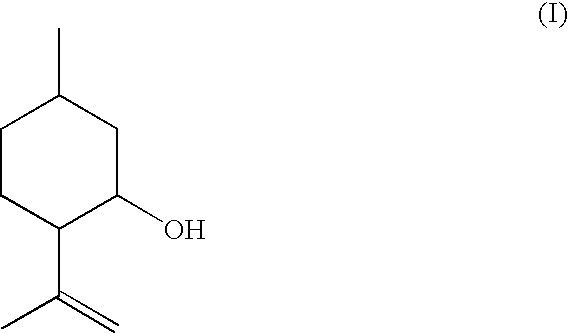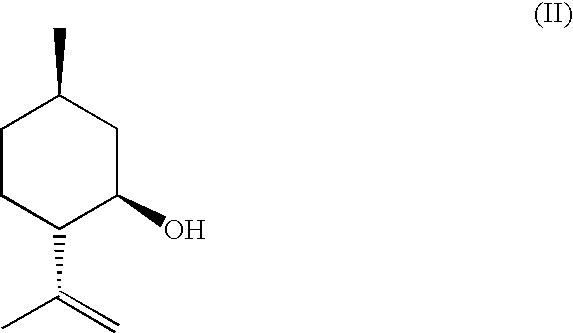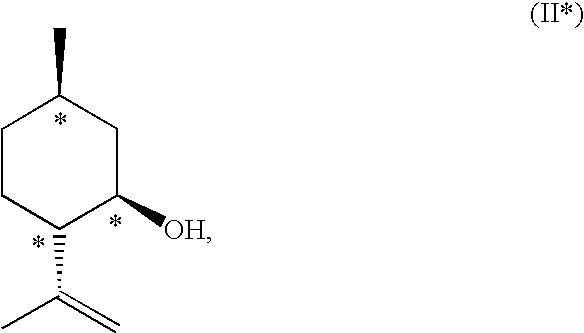Method for the production of enriched isopulegol
a technology of isopulegol and enriched isopulegol, which is applied in the preparation of oxygen-containing compounds, organic chemistry, and product crystallization on the bed of the crystallization bed, etc., can solve the problems of no significance for an industrial application, multi-stage purification of natural menthol is therefore always unavoidabl
- Summary
- Abstract
- Description
- Claims
- Application Information
AI Technical Summary
Benefits of technology
Problems solved by technology
Method used
Image
Examples
example 1
Static Layer Crystallization of an Isopulegol Melt
[0046]A jacketed glass tube as a crystallizer was initially charged with 205 g of isopulegol of composition 95% (−)-n-isopulegol and 5% (+)-n-isopulegol (90% ee) with a melting point of 13° C. at a temperature of 15° C. The crystallizer was cooled down to 9° C. within 30 h. The initially liquid product was present for the most part in solidified form at the end of the experiment. Subsequently, the jacket temperature was raised from 13° C. to 25° C. within 10 h. In addition to 70 g of mother liquor and 50 g of sweating fractions, 85 g of molten crystal layer were obtained. This end product had an optical purity of 99.9% ee based on (−)-isopulegol.
example 2
Dynamic Layer Crystallization of an Isopulegol Melt
[0047]A stirred apparatus with a planar bottom cooled by means of a jacket (as described in G. F. Arkenbout, Melt Crystallization Technology, Lancaster / Pa., Technomic Publ. Co., 1995 (ch. 10.4.1)) was initially charged with 1003 g of isopulegol of composition 94.7% (−)-n-isopulegol and 5.3% (+)-n-isopulegol (89.4% ee) with a melting point of 10° C. at a temperature of 12° C. The cooling jacket of the crystallizer bottom was cooled to −14° C. over the course of 2 h. In the course of this, a 12 mm-thick crystal layer with a weight of 124 g formed. Subsequently, the apparatus was turned through 180° and the jacket temperature was raised from 8° C. to 13° C. within 10 h. This afforded 52 g of sweating fractions and 124 g of molten crystal layer. This end product had an optical purity of 99% based on (−)-n-isopulegol.
example 3
Suspension Crystallization of an Isopulegol Melt
[0048]A 1 l stirred crystallizer (as described in Arkenbout, ch. 10.4.2) was initially charged with 860 g of an isopulegol isomer mixture having an optical purity based on (−)-n-isopulegol of 95.2% (90.4% ee) as a melt. The melting point of the mixture was approx 10° C. The stirrer used was a close-clearance helical stirrer. In situ seeding of the melt was achieved by brief cooling down to 3° C. and subsequent heating to 9° C. Subsequently, the apparatus was cooled to 7° C. with stirring within 1.5 h, This established a solids content of the suspension of approx. 35% by weight. From this suspension, a sample was taken and freed of adhering mother solution by centrifugation. After centrifuging for one minute, the crystals had a purity of 99% ee based on (−)-n-isopulegol, and of 99.4% after centrifuging for five minutes.
PUM
| Property | Measurement | Unit |
|---|---|---|
| temperature | aaaaa | aaaaa |
| enantiomeric excess | aaaaa | aaaaa |
| enantiomeric excess | aaaaa | aaaaa |
Abstract
Description
Claims
Application Information
 Login to View More
Login to View More - R&D
- Intellectual Property
- Life Sciences
- Materials
- Tech Scout
- Unparalleled Data Quality
- Higher Quality Content
- 60% Fewer Hallucinations
Browse by: Latest US Patents, China's latest patents, Technical Efficacy Thesaurus, Application Domain, Technology Topic, Popular Technical Reports.
© 2025 PatSnap. All rights reserved.Legal|Privacy policy|Modern Slavery Act Transparency Statement|Sitemap|About US| Contact US: help@patsnap.com



